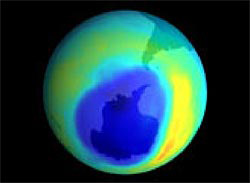Inside the Ozone Layer

Research about stratosphere damage helps us understand the ozone layer better, include Antarctic ozone "hole" that is three times larger than the entire land mass of the United States—the largest such area ever observed. (Image courtesy the TOMS science team & and the Scientific Visualization Studio, NASA GSFC via Visible Earth at http://visibleearth.nasa.gov)
Researchers quantify stratosphere damage with an eye toward ozone hole recovery
A new atmospheric model is able to quantify man-made versus naturally occurring damage to the stratosphere with an eye toward repairing the diminishing ozone layer that is located within the stratosphere. That’s the premise of a paper published in this week’s Science titled, “Anthropogenic and Natural Influences in the Evolution of Lower Stratospheric Cooling.”
Researchers used a model to observe the stratosphere, the layer above the troposphere, and better understand what has contributed to its cooling over the past approximately 25 years. The stratosphere contains the ozone layer, which absorbs sunlight and heats the stratosphere. This long-term cooling trend is generally accepted to result from the loss of the ozone layer as a result of man-made influences. However, the cooling trend is not uniform like ozone loss, but rather broken into a series of jumps or discontinuities. These jumps are associated with major volcanic (El Chichon in 1982 and Mt. Pinatubo in 1991) eruptions that inject aerosols into the stratosphere. The aerosols also absorb sunlight and heat the stratosphere, thus temporarily offsetting the cooling trend from ozone loss. The volcanic eruptions are considered to be a “natural” forcing.
The model that researchers used to evaluate the influences, both man-made and naturally occurring, included not only the ozone loss and volcanic eruptions, but also solar activity, and a few other variables that also affect stratospheric temperature. What they found was that when all these factors are included, the model does an excellent job of reproducing the observed cooling of the stratosphere over the record of satellite observation from 1980 to 2005 — both the long-term cooling trend and the jumps.
“Since we can make this determination, it gives us confidence in the model’s ability also to predict future cooling of the stratosphere over the next century from increasing greenhouse gases, such as carbon dioxide,” said University of Miami Rosenstiel School’s Dr. Brian Soden, who is among the paper’s six authors.
Venkatchalam Ramaswamy, from NOAA’s Geophysical Fluid Dynamics Laboratory (GFDL) in Princeton NJ, is the lead author on this paper, which also includes the work of Soden, Dan Schwarzkopf from NOAA’s GFDL, Bill Randel from the National Center for Atmospheric Research, Ben Santer from the Program for Climate Model Diagnosis and Intercomparison at Lawrence Livermore National Laboratory, and Georgiy Stenchikov at the Department of Environmental Sciences at Rutgers University.
“While most people equate a warmer atmosphere with global warming, the stratosphere is a section of the atmosphere which actually cools in response to increasing greenhouse gases,” Soden said.
Increasing carbon dioxide warms the earth’s surface and troposphere, but eventually it actually cools the stratosphere. In the next century, carbon dioxide will likely become the dominant contributor to stratospheric cooling. And, future stratospheric cooling, in turn, may have important implications for the rate of recovery of the ozone hole in the southern hemisphere and possibly even the loss of ozone over the polar regions of the northern hemisphere.
Rosenstiel School is part of the University of Miami and, since its founding in the 1940s, has grown into one of the world’s premier marine and atmospheric research institutions.
Media Contact
All latest news from the category: Physics and Astronomy
This area deals with the fundamental laws and building blocks of nature and how they interact, the properties and the behavior of matter, and research into space and time and their structures.
innovations-report provides in-depth reports and articles on subjects such as astrophysics, laser technologies, nuclear, quantum, particle and solid-state physics, nanotechnologies, planetary research and findings (Mars, Venus) and developments related to the Hubble Telescope.
Newest articles

Properties of new materials for microchips
… can now be measured well. Reseachers of Delft University of Technology demonstrated measuring performance properties of ultrathin silicon membranes. Making ever smaller and more powerful chips requires new ultrathin…

Floating solar’s potential
… to support sustainable development by addressing climate, water, and energy goals holistically. A new study published this week in Nature Energy raises the potential for floating solar photovoltaics (FPV)…

Skyrmions move at record speeds
… a step towards the computing of the future. An international research team led by scientists from the CNRS1 has discovered that the magnetic nanobubbles2 known as skyrmions can be…





















